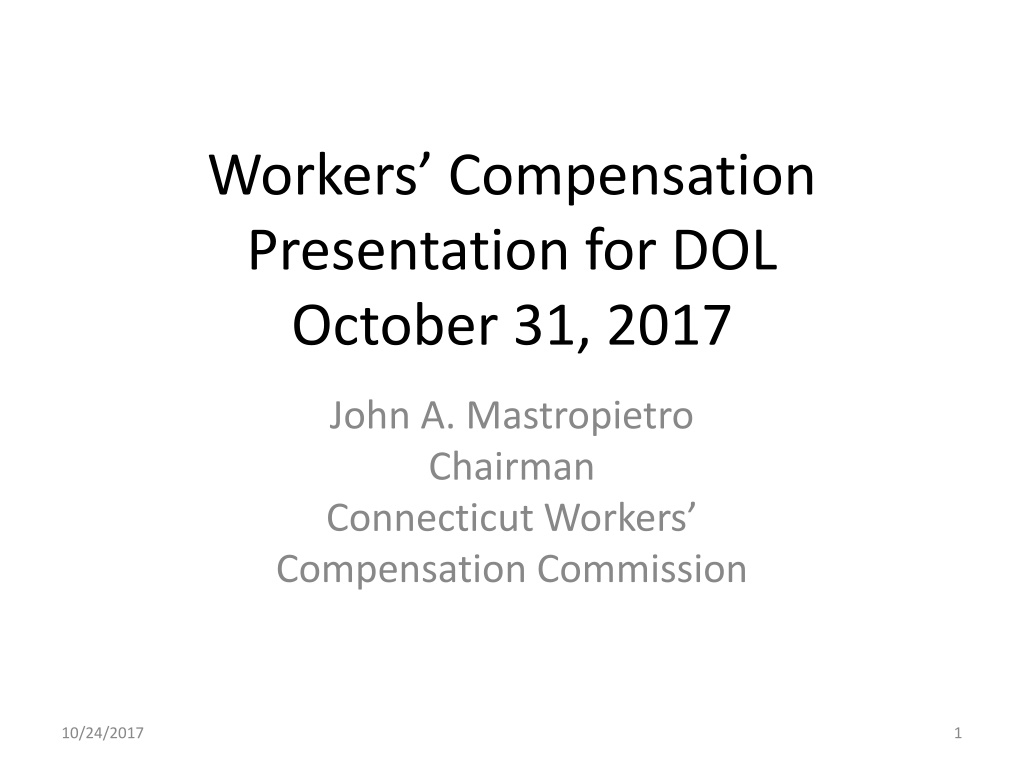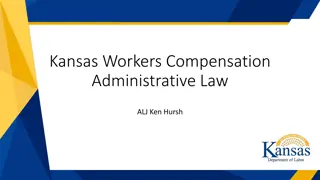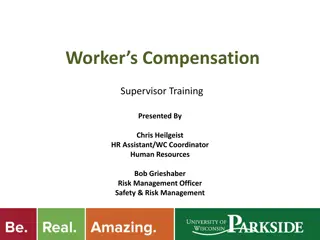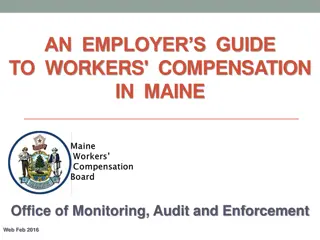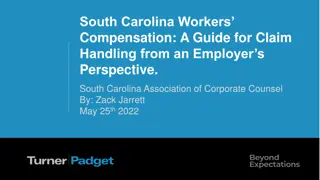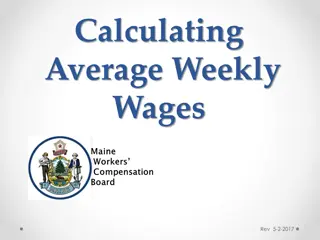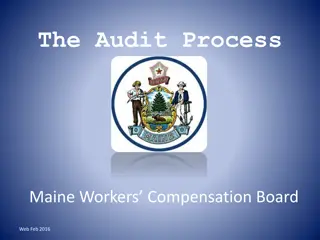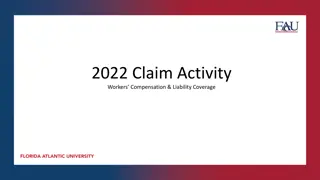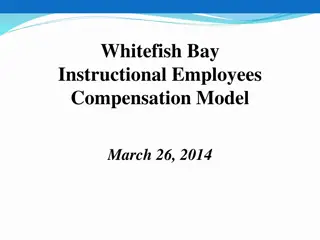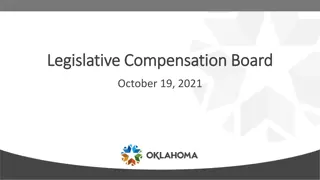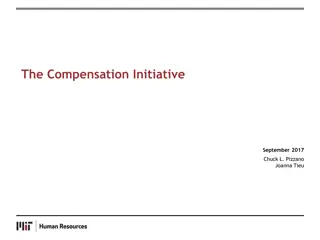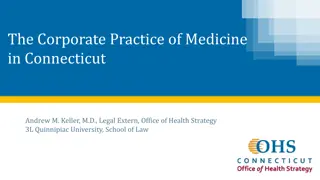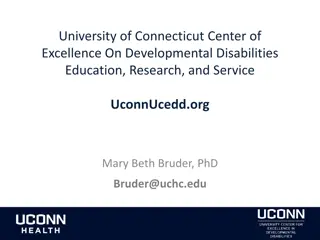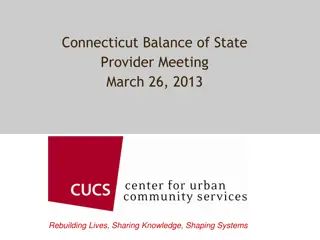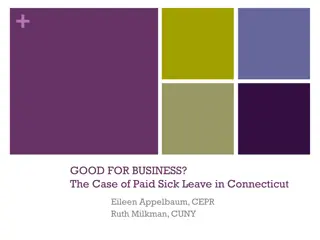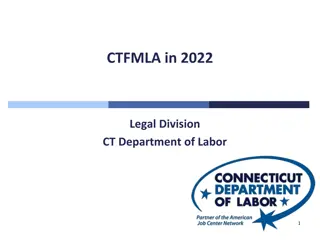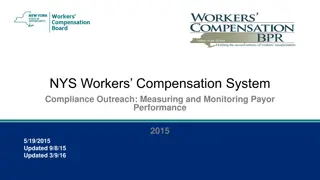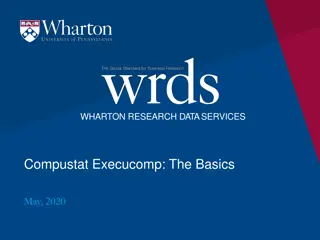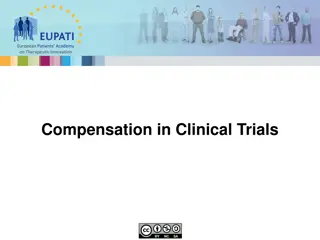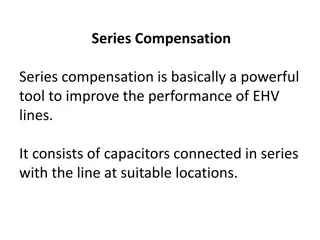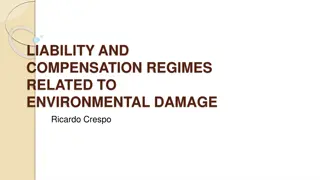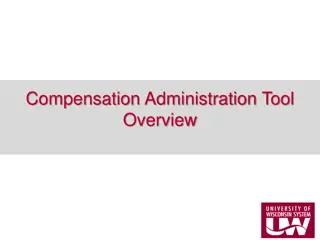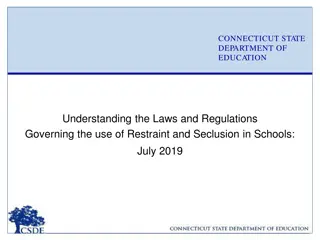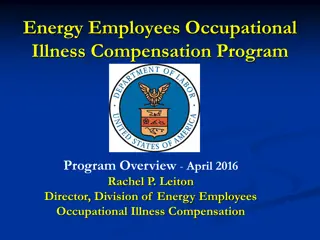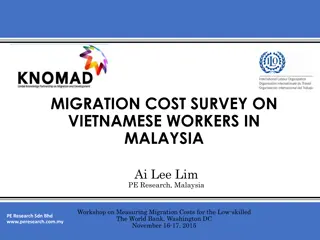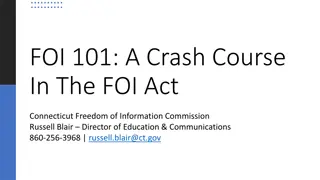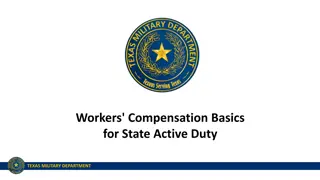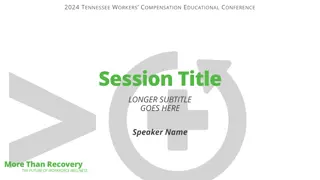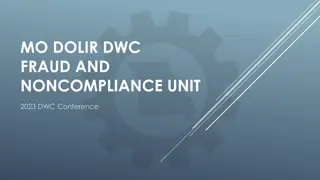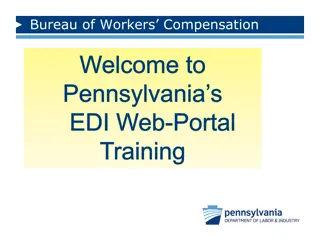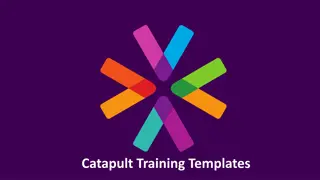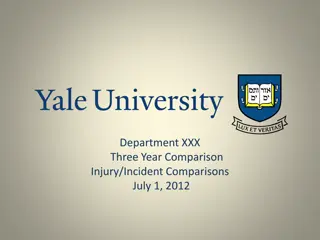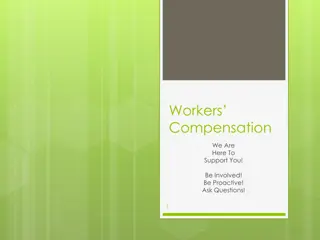Understanding Connecticut Workers' Compensation Act
This presentation provides an overview of the Connecticut Workers' Compensation Act, explaining who is entitled to benefits and the types of benefits available. It delves into the history of workers' compensation laws in Connecticut, highlighting the Triangle Shirtwaist Fire as a turning point in the adoption of such legislation. The presentation emphasizes the essence of the remedy, which includes medical care, wage replacement, and specific indemnity for workers who sustain injuries in the course of their employment.
Download Presentation

Please find below an Image/Link to download the presentation.
The content on the website is provided AS IS for your information and personal use only. It may not be sold, licensed, or shared on other websites without obtaining consent from the author. Download presentation by click this link. If you encounter any issues during the download, it is possible that the publisher has removed the file from their server.
E N D
Presentation Transcript
Workers Compensation Presentation for DOL October 31, 2017 John A. Mastropietro Chairman Connecticut Workers Compensation Commission 10/24/2017 1
Workers Compensation- An Overview Simple Definition Provides medical and monetary benefits to workers who sustain an injury in the course of their employment 10/24/2017 2
Workers Compensation Who s entitled to Workers Compensation benefits? What kinds of benefits are available under the Workers Compensation Act? 10/24/2017 3
Entitlement Any employee who sustains a personal injury which arises out of and in the course of his employment. The Act does not require proof of negligence Changing work force and types of injuries 10/24/2017 4
Workers Compensation System 2013 Marked the 100th anniversary of Connecticut s Workers Compensation Act Before Workers' Compensation Act Injured workers could bring a claim for damages in civil court for injuries sustained at work Workers had to show negligence on the part of the employer produced the claimed injury 10/24/2017 5
Triangle Shirtwaist Fire On March 25, 1911 fire broke out on the 8th, 9th and 10th floors of the building where the Triangle Shirtwaist Factory operated Within minutes 146 employees were killed People were trapped, an exit door was locked to prevent employee theft Impetus for adoption of Workers Compensation legislation Connecticut adopted its Act in 1913 10/24/2017 6
Connecticuts Workers Compensation Act Connecticut adopted its Workers Compensation Act in 1913 System has been tweaked over the years but the essence of the remedy remains the same Medical Care Wage Replacement 10/24/2017 7
Remedy Medical Care Monetary Benefits Wage Replacement Specific indemnity (payment for the loss of use or function of a body part) 10/24/2017 8
Remedy-Wage Replacement Permanent Total Must meet specific statutory criteria 31-307(c) Temporary Total Provides a wage replacement for the period claimant is healing 31-307(a) 10/24/2017 9
Temporary Total Disability Amount and rate depends on what the statute allowed at the time of the injury Consists of claimant s compensation rate with a COLA if applicable. Claimant s compensation rate paid during the period the claimant is unable to perform any work Compensation rate computed on a percentage basis of the claimant s average weekly wage 10/24/2017 10
Temporary Total Disability Current Computation of Compensation Rate Average Weekly Wage computed for 52 weeks prior to the injury Total earnings for the 52 weeks divided by the number of weeks of employment Claimant is entitled to 75% of his average weekly wage once state income tax, federal income tax and social security deductions are made 10/24/2017 11
Temporary Total Date of Injury Compensation Rate Average Weekly Wage 26 weeks 66 2/3 of gross 10/1/67- 9/30/91 26 weeks 80% AWW less federal income tax and FICA deductions 10/01/91- 6/30/93 52 weeks 75 % AWW less federal, state income taxes and FICA deductions 7/1/93- current 10/24/2017 12
Temporary Partial Paid for the period between the date of injury and the time that the claimant is able to return to some work even if unable to return to his regular employment (Light Duty) 31-308(a) Employer is obligated to provide light duty if available 31-313 10/24/2017 13
Permanent Partial Disability Also referred to as specific provides compensation for the loss of use of the body part or its function Compensation for loss enumerated in 31- 308(b) Paid in accordance with schedule set out in 31-308(b) 10/24/2017 14
Wage Loss Differential Additional benefits provided in 31-308a. Such benefits are within the discretion of the Commissioner Capped by the number of weeks awarded pursuant to 31-308(b) [Specific] Must be available to work in Connecticut. 10/24/2017 15
Medical Benefits (generally) Claimant is entitled to reasonable or necessary medical care Must be curative not palliative However palliative acceptable if it increases functionality, e.g., improves ability to work 10/24/2017 16
Workers Compensation The Process 90-95% of all claims are resolved without resorting to the Workers Compensation dispute resolution process Last year the Commission held ____hearings 10/24/2017 17
Workers Compensation The Process Begins with an injury Filing of a Claim Written notice of claim Identification of a dispute Request for a hearing 10/24/2017 18
Hearing Process Dispute Resolution Process Begins at the District Level Informal Hearing Pre-Formal Hearing Formal Hearing 10/24/2017 19
Hearing Process-Informal Hearing (Continued) Informal Hearing Short informal meeting between the parties in a workers' compensation case Presided over by a Workers' Compensation Commissioner First level of dispute resolution Purpose to narrow issues 10/24/2017 20
Hearing Process-Informal Hearing (Continued) How do you get an informal hearing? File a hearing request The hearing request form requires that the parties attempt to resolve issues before requesting the hearing 10/24/2017 21
Hearing Process-Pre-formal Pre-formal Hearing -analogous to a Superior Court's pretrial proceeding Generally allows one last chance to try to resolve issues before proceeding to a formal hearing May include a discovery schedule order 10/24/2017 22
Hearing Process Pre-Formal (Continued) Discussion of formal hearing logistics; witnesses to be called time to be allotted particular accommodations (e.g., need for interpreter) firm identification of issues 10/24/2017 23
Hearing Process Formal Hearing Formal hearing Analogous to a bench trial in Superior Court Parties put on evidence Live Testimony - Witnesses Deposition Medical Reports Claimant has the burden of proof 10/24/2017 24
Hearing Process Formal Hearing (Continued) The burden of proof standard in the Workers Compensation forum is the same as it is in civil court proceedings; the party who carries the burden must establish the existence or non-existence of a fact by a preponderance of the evidence 10/24/2017 25
Hearing Process Formal Hearing (Continued) Commissioner acts as an ALJ Makes factual findings based on evidence presented Considers and applies appropriate law to findings Draws legal conclusions Renders decision in the form of a Finding and Award/Finding and Dismissal 10/24/2017 26
Hearing Process Appellate Hearings Appellate Hearing If a party is of the opinion that the trial commissioner committed legal error then they can appeal to the Compensation Review Board [CRB] CRB is the first tier in the appellate process CRB opinion can be appealed to Appellate Court and Supreme Court 10/24/2017 27
Hearing Process Appellate Hearings (Continued) The CRB forms the basic body of case law, i.e., interpretation of statutes. Courts often refer and defer to the agency s interpretation and view on statutes and policy . Principals of Stare Decisis Decisions of CRB available on the agency s web page 10/24/2017 28
Hearing Process Appellate Hearings (Continued) What is the principal of Stare Decisis? To abide by, or adhere to, decided cases. Policy of courts to stand by precedent and not to disturb settled point. Doctrine that, when court has once laid down a principle of law as applicable to a certain state of facts, it will adhere to that principle, and apply it to all future cases, where facts are substantially the same; regardless of whether the parties and property are the same. 10/24/2017 29
Workers Compensation Up Close What can the employer do to assure compliance in a cost-effective manner? 10/24/2017 30
Employers Perspective -Medical Care As soon as an employee tells you he has sustained a work-related injury you must provide him with immediate medical care. One of the goals of Workers Compensation is to restore the injured worker to health and a return to work 10/24/2017 31
Employers Perspective Medical Care (Continued) If you belong to a Workers Compensation approved Managed Care Plan you must provide the employee with the list of physicians from which they may choose their treater. If you do not belong to a Managed Care Plan the employee may choose any physician licensed to practice medicine in the State of Conn. Under NO circumstances may you direct you employee s medical treatment. 10/24/2017 32
Employers Perspective - Medical Care (Continued) Medical provider fees subject to the Workers' Compensation medical provider fee schedule Hospital, Ambulatory Surgical Center fees subject to the hospital/ambulatory surgical center fee schedule 10/24/2017 33
Employers Perspective - Medical Care (Continued) Medical provider fees subject to the Workers' Compensation medical provider fee schedule Hospital, Ambulatory Surgical Center fees subject to the hospital/ambulatory surgical center fee schedule 10/24/2017 34
Employers Perspective- Wage Loss Benefits You must pay the employee the full day s wages the day of injury. Thereafter, the insurance company will mail any checks directly to the employee, or his attorney. You must submit a wage statement to the insurance company listing all income earned by the employee for the last 52 weeks prior to injury, including OT, shift differential and bonus pay. You must allow the employee to receive treatment on company time with no loss of wages. 10/24/2017 35
Employers Perspective- Wage Loss Benefits (Continued) Unless you are a state or municipal employer, you do not have to maintain your employee s medical coverage while they are out on comp. You must, however, offer them COBRA benefits for up to 18 months. If your business requires you to replace your injured employee you may do so, as there is no job protection mandated under the Workers Compensation Act. If your employee s claim is denied you must file for any other available medical or disability benefits to which the employee would be entitled. 10/24/2017 36
Employers Perspective- Wage Loss Benefits (Continued) A few caveats Maintenance of health benefits through COBRA should occur only after the claimant is separated from employment. During period Claimant is on temporary total with an expectation to return to work for the same employer, claimant is liable for any premium contribution 10/24/2017 37
Employers Perspective- Wage Loss Benefits (Continued) Caveats - Continued Employer must be aware that they cannot terminate an injured worker or treat them disparately because they filed a Workers' Compensation claim. Claims for wrongful discharge may be pursued in the Workers' Compensation forum or Superior Court Costs and damages relating to wrongful discharge are not covered by a Workers Compensation insurance policy 10/24/2017 38
Employers Perspective- Wage Loss Benefits (Continued) Caveats continued Courts have held discharge permissible if part of a mutually applied absence control policy Reminder claimant's absence may be subject to FMLA Courts have held discharge permissible if part of a mutually applied absence control policy 10/24/2017 39
Workers Compensation -Medical Care Plans An employer can choose to participate in a Workers' Compensation approved medical care plan The objective of such plans is to provide a network of providers to treat injured workers thereby assuring quality of care at lower costs Providers are generally paid at a discounted rate off the provider fee schedule 10/24/2017 40
Workers Compensation -Medical Care Plans (Continued) Network providers are generally providers with experience in treating injured workers They are educated in all the obligations assumed by physicians in rendering treatment under the Act 10/24/2017 41
Workers Compensation -Medical Care Plans (Continued) Allows employees to continue to exercise their right to select a treating provider Allows the Workers Compensation Commission greater control over the provider s participation Allows employers to provide quality medical care at a reduced cost 10/24/2017 42
Workers Compensation Administration of Medical Care The Workers Compensation Tool Box To Avoid Litigation Guidelines for Cooperation Between Providers and Payors Medical protocols When in Litigation Guidelines for Cooperation between Attorneys and Medical Providers 10/24/2017 43
Workers Compensation Administration of Medical Care (Continued) Purpose of Guidelines for Cooperation Between Payors and Providers- Facilitate Communication Assure timely decisions so as provide injured workers with the best and most appropriate treatment in the most timely manner. Assure productive use of hearing docket 10/24/2017 44
Workers Compensation Administration of Medical Care (Continued) Give each side to the dispute a framework for how they are to conduct themselves and what they may reasonably expect from the other side May serve as framework for determining if a respondent has engaged in undue delay or violated other sanctions under the Act 10/24/2017 45
Workers Compensation Administration of Medical Care (Continued) The Guidelines provide examples of medical treatment/diagnostics where payor s pre-approval not required The Guidelines provide deadlines by which telephone call and inquiries must be responded to 10/24/2017 46
Workers Compensation Administration of Medical Care (Continued) Why do the Guidelines work? Because if we, the stakeholders, don t regulate conduct a remedy will be imposed by the legislature Generally such statutory remedies carry unintended consequences that disserve both payors and providers 10/24/2017 47
Workers' Compensation Medical Protocols Medical Protocols Opioid guidelines Cervical Spine Lumbar Spine Hand, Wrist, And Elbow Shoulder Knee Psychological Pain Assessment and Management Foot and Ankle (in development) 10/24/2017 48
Workers' Compensation Medical Protocols (cont d) The Medical Protocols Serve as Guidelines Foster Communication as it provides a basis for treatment expectations Serve as a de-facto governor Indicates what is acceptable treatment and therefore narrows the field of reasonable contests to treatment disputes 1/6/2014 UCONN Health Center 49
Workers Compensation Administration of Wage Replacement Benefits Another toolbox Light Duty Self Insurance Health and Safety Committees 10/24/2017 50
